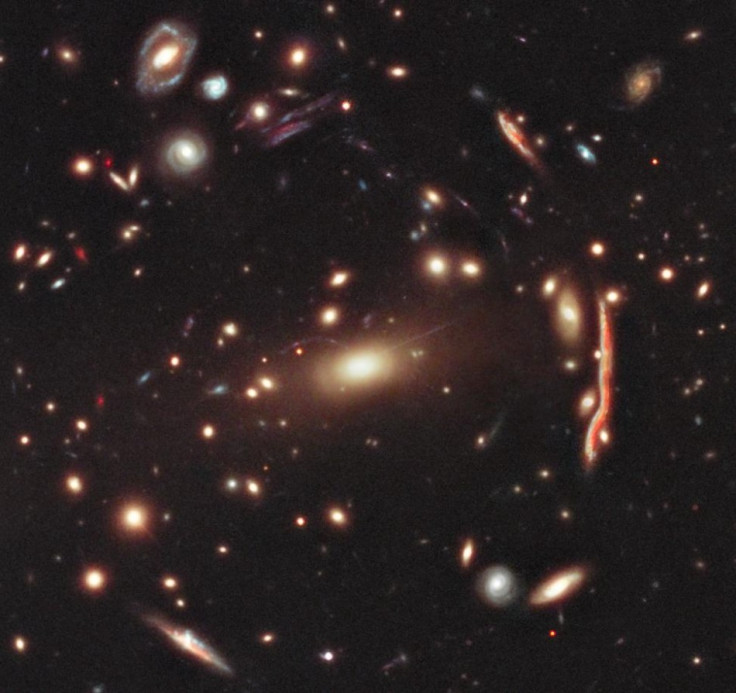Dark matter has new 'crazy' candidate which is light and interacts strongly with matter

In a paradigm shift, researchers at the University of Southampton are proposing a new, fundamental and 'crazy' candidate particle for the elusive dark matter that makes up 85% of the mass of the universe.
Their proposed particle is light and has a mass of about 0.02% that of an electron. It does not interact with light, but interacts surprisingly strongly with normal matter.
Interaction with matter has been believed to be feeble, if at all existing, in all hypothesis of dark matter.
Another point of contrast with prevailing theories is that the new particle candidate may not even penetrate earth's atmosphere, says the study.
This could explain why no one has managed to detect it.
The team plans a space experiment with the Macroscopic quantum resonators (MAQRO) consortium to detect the particles.
A nanoparticle held in space and exposed directly to the flow of dark matter, will be pushed downstream and the resonators will pick this movement to reveal the nature of the dark matter particle, if it exists.
Dr James Bateman, from Physics and Astronomy at the University of Southampton and co-author of the study, says: "Our candidate particle sounds crazy, but currently there seem to be no experiments or observations which could rule it out. Dark Matter is one of the most important unsolved problems in modern physics, and we hope that our suggestion will inspire others to develop detailed particle theory and even experimental tests."
Standard particle physics confers very large mass on dark matter, comparable to that of heavy atoms. Lighter dark matter particles are considered less likely.
Recent evidence
In data collected by the European Space Agency's XMM-Newton spacecraft, a team of researchers recently observed an odd spike in X-ray emissions coming from the Andromeda galaxy and the Perseus galaxy cluster.
Since the signal does not correspond to any known particle or atom, dark matter is being considered.
"The signal's distribution within the galaxy corresponds exactly to what we were expecting with dark matter — that is, concentrated and intense in the center of objects and weaker and diffuse on the edges," study co-author Oleg Ruchayskiy, of the École Polytechnique Fédérale de Lausanne (EPFL) said.
Dark matter has been inferred indirectly by its massive gravitational effect on stars and galaxies, bending of light rays and its imprint on the Cosmic Microwave Background.
Scientists believe dark matter plays a major role in the way the universe is evolving, but the nature of dark matter is totally a mystery.
Even the simplest models of the universe suggest dark matter interactions have not delivered on the actuals. The dark stuff remains elusive.
Axions, WIMPS or a mix?
Leslie Rosenberg, a physicist with the University of Washington, is among those investigating the possibility that axions make up dark matter. Axions are hypothetical particles with a fraction of the mass of an electron.
The Axion Dark Matter eXperiment seeks evidence of this extremely lightweight particle converting into a photon in a high magnetic field.
WIMPS, weakly interacting massive particles, are the other contenders. The Large Underground Xenon, or LUX, experiment, which began in 2009, is getting an upgrade to increase its sensitivity to heavier WIMPs.
The Super Cryogenic Dark Matter Search collaboration, which has looked for the signal of a lightweight WIMP barrelling through its detector since 2013, is undergoing upgrades too in design.
Some scientists are suggesting dark matter to be a composite made of axions, and heavy and light WIMPS.
More recently, scientists like Case Western Reserve University physics professor Glenn Starkman are looking at less exotic, less ordinary roots for dark matter. This could be between the exotic and very ordinary, like chunks of strange nuclear matter or unknown states of quarks.
The latest Southampton proposal is a move in that direction which could fit in with the standard model of particle physics.
© Copyright IBTimes 2025. All rights reserved.





















